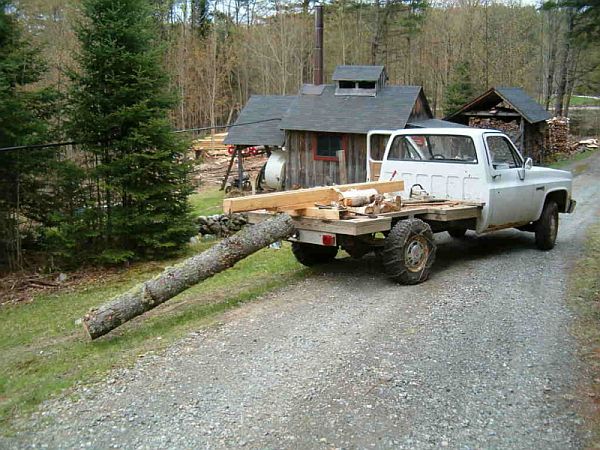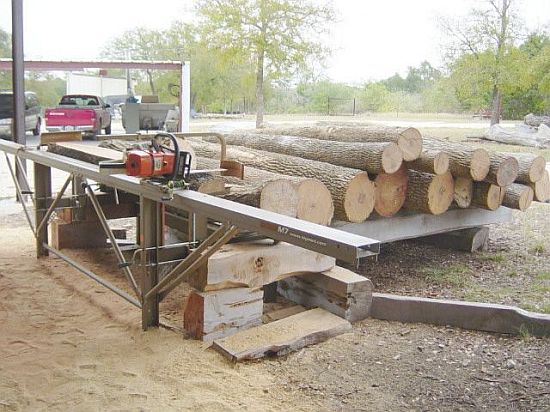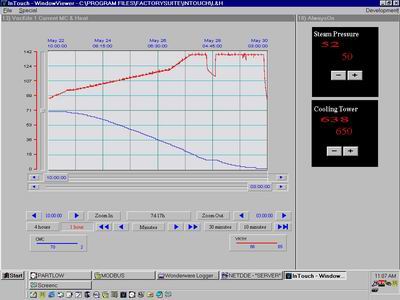Shopping for Portable Sawmills
Portable sawmill owners and would-be owners discuss equipment preferences, operating characteristics, and why they even bother in the first place. November 13, 2005
Question
I've been doing a lot of research into sawmills of all kinds (band, chainsaw, swing) because I have access to inexpensive or free logs from local sources. I am strictly looking to saw for my own use or perhaps a very limited customer base. It would be 4/4 and 5/4 stock mostly, with maybe an occasional beam for a timber frame shed. I just bought a Camline 6x12 dump trailer (11,900K GVW) and I'm towing it with a 2004 Dodge 2500 Diesel. I don't plan to do any mobile sawing. The plan is that the source would load the logs and then I can easily dump them near the mill. The logs in question would be less than 24" and only 12' long. I canít handle anything larger since I have no support equipment.
Are the smaller bandmills, such as the Oscar 18/28, Norwood LumberLite, Woodchuck, etc. worth it for cutting this size wood or would I be better off getting something like a Logosol? I understand the yield is greater with bandmills vs chain mills and that more power is better, but that's not an issue for me. I don't want to get too much mill and feel guilty about having many thousands of dollars sitting idle for most of the year. On the other hand, I don't want a bandmill that bogs down to a lethargic crawl and doesn't track straight. Any comments or suggestions would be appreciated.
Forum Responses
(Sawing and Drying Forum)
From contributor A:
I recently purchase an Oscar 36" Hudson to add a little diversity to what I produce with a Mobile Dimension mill. I wanted to work some special small diameter and short unique logs as well as process the Western Big Leaf Maple that I buy and sell. I have found that just after 3 months I have over half my dollar investment returned in the work it has accomplished.
From contributor B:
I had a Baker/Enercraft manual bandsaw mill for 2 years. It had a 20 horsepower Honda and I would not have wanted much less when cutting 24" hard maple logs. Handling the logs and boards is 100 times tougher than pushing the mill through the log. In fact, I think I could cut better than a power feed Woodmizer because I could feel the cut and slow when the going got tough. I also had a better sense when the blade was getting dull. I would have loved to have had a hydraulic log turner and loader. After two years of heavy use, I sold the demonstrator machine that I had bought on a great discount, for $300 more than I paid for it. Any kind of small mill has great resale. I have about 5000 board feet of lumber for just the cost of my labor. The extra $300 paid for all my blades. My reason for selling is that I have enough lumber to last at least 2 more lifetimes, I'm 52 now and won't get it all made into furniture before the hands and eyes get really bad. I think that even the speed of a lower horsepower band mill is better than a chainsaw mill. The only maintenance I did in two years to my mill was keeping it greased and changing the oil. I don't know if the chainsaw guys can say that or not.
From contributor C:
Did you consider a Procut? A Procut is a chainsaw mill that you can build for under $900.00.The plans are very easy to read and can be purchased on the web.
From the original questioner:
I've looked at them and even purchased some bandmill plans, but I don't want to build one. I can afford to buy one, and I'd rather be sawing than welding and fabricating.
From contributor D:
We saw for our own use and have tried a couple different bandmills. Then we got a chainsaw mill which we got rid of immediately because it was way too slow. We purchased a Norwood Lumber Mate last year and we are very pleased with it. If you don't mind putting it together, this machine is the best we have had for the price. We got the 23 hp Briggs motor on it and feel this is well worth the few extra bucks. It is an all manual mill but it is not hard at all to push the carriage while cutting. We use a cant hook to turn the logs and it is not that hard to turn a 12' X 24" log. I even turn 12' x 30" logs by myself with the cant hook, and we load the logs on the mill with a skid loader.
We have sawn approximately 18,000 bf of 10/4 walnut, 3,000 bf 4/4 locust and a couple thousand bf of oak since we made the purchase and have had no problems except a problem with the clutch, which Norwood replaced free of charge. When the mill arrived it was on one wooden pallet and I thought it was going to be a nightmare to put together, but it went together really well, everything fit together without pounding, cussing or any of the usual problems.
The instructions were very clear, and all parts were well marked and identifiable. If I was to buy another mill it would be the Norwood Lumber Mate.
From contributor E:
I'm an assistant manager for 300 acres of timberland in a silviculture operation, and we needed a small bandsaw mill to process the lower grade cull trees such as Beech, Hemlock, Birch, Sycamore, etc. After doing some research on sawmills, we concluded that the Turner manual bandsaw mill with a 10 hp. Baldor motor was the best value for us. Production capabilities are around 300 board feet per hour, price is about $4,500.00 - $5,000.00.
From contributor F:
The small bandmills are fine for what you want to do. I would not buy one of any brand till I tried it. Call the companies and find a mill like you want and go try it out. Also, there are shows and open houses where you can go saw with one. Look at used mills as well. Often with a used mill you can get extras like blades and tools. Since you have a good way to get the logs maybe you could hire the sawing done on your logs to see if this deal is going to work for you. The $4,000 you spend on a mill could buy you 15,000+ bdft of sawing without any of the headaches of ownership. If it goes well then you will know if you want to spend the money for a mill.
From contributor G:
I bought an MP-32 Cooks bandmill with 16 hp Kohler, 16' bed and trailer package three years ago. It is a great mill and a great family-owned company. I milled for years with an Alaskan mill and 281 husky saw. I got tired of the big kerf and eating sawdust. I researched the market for months and have never regretted choosing Cooks. I have many custom sawing jobs and I can work just as much as I want to!
From contributor H:
Support equipment is not necessary. I did my home work about 5 yrs ago - watched bandsaws, and did a lot of talking. I bought a Lucas. I have support equipment, but I can mill the big logs easily, without needing the support equipment. I donít need an edger, and maintenance and expendable supplies are low. Regarding the ease of transport and setup, I can fit the Lucas Mill in the back of my Toyota Tacoma Pickup Lumber rack and 6 foot bed. Remember, sometimes itís a opportunity to mill onsite - it becomes a great source of advertisement.
From contributor I:
You sound very much like me - doing this primarily for fun and maybe sell a few boards if it isn't too much trouble. Last fall I bought a Wood-Mizer LT15. I have had an absolute ball with it. I also have access to free logs and it is amazing how the word gets around when people learn you have a mill. I'm about to go pick up a 30" black walnut tree. I've sawn walnut, pecan, cedar, and sycamore. I've built a solar kiln and I'm also nearly to the point where I have so much wood I'll be giving some away. I think you will have a great time producing your own lumber. I can only vouch for the LT15 because I have no experience with any others, but I love it! I've also been amazed at what one man, a Polaris 4-wheeler, and one good cant hook can do to defy the laws of nature while getting a log at ground level moved and rolled up on the frame of a sawmill. You will, too! Just two days ago I placed some of my wood, mainly spalted pecan, up for sale on EBay to see what would happen because my woodworking hobby is now also a small business. Whether I sell any wood or not, it sure is fun to make beautiful boards from scratch.
From contributor J:
Here's another vote for the Norwood Lumbermate. Iíd suggest the 2000 model Ė you will have a saw that will last a lifetime. Putting it together is a great way to learn all about your new mill. The standard LM2000 would do everything you want to do, and if you decide you want to saw some lumber for others, it's easily up to the task. In my opinion it's absolutely the best saw for the price.
From contributor K:
I bought plans for the bandsaw mill from Bill Reeks. I made it using a Briggs 8hp engine, and am using Grizzly 154.5" blades. I have made my own set for the teeth, left center and right, and have converted a chainsaw grinder to be a bandsaw blade sharpener. I have about $500 in the works. Then I made a straddle-trailer for moving logs. It handles up to 20" diameter and up to 14' long. I just back over the log, get my winch cables under the log, and winch up each end and the chain it in place.
From contributor L:
I bought the Oscar 30 about 4 months ago and I am happy with it. I got the 16HP electric start and trailer options. I have no support equipment except a pickup with a wooden boom with come-along to drag logs to the mill area. I have no problem loading and rotating logs up to 20" x 16'. While you can saw 1000 feet of typical framing lumber in a day, 300 BF is typical if you deal with the slabs, stick the lumber, move sawdust, etc.

From contributor M:
I would recommend a Logosol. I have milled about 8000 bf with mine, and the logs in the picture were milled in one day. True, a bandmill would be faster and take out less kerf, but after you plane out the wave of the band from a bandmill sawn log, you will have about the same yield from the log. My 16" bar does not ride up or down when encountering knots. This mill is very versatile and can be turned upside down on top of the big logs and you do not have to mess with lifting the big fellows. The mill weighs 110 lbs without the saw. The saw will slip right off the mill and I can fell the tree with it too. I have a 16", 25", and 36" bar or my Stihl 066. Contact Logosol and find the name of an owner close to you and go see a demonstration. I demo for people all the time.

From contributor N:
I have a Norwood LM2000 with the 23 hp Briggs. It is a great mill. It cuts dead straight. Norwood has an excellent mill, if youíre the kind of person who enjoys assembling, as it comes completely unassembled. You save big bucks as you are not paying a high priced welder to put it together. It is 100% bolt together, and is better then the welded frames because if you have a catastrophe you will only damage a section, and that can be replaced easily. A welded frame becomes a throwaway if you bend it. It cuts dead straight through knots.
From contributor L:
Bandsaws will create waves when the blade gets dull, or when using the wrong type of blade for the wood you are sawing.
From contributor J:
That's true, just like a chainsaw doesn't cut right when the chain needs sharpening. It's called operator error. I do not use different blades for different logs, except frozen logs. They need a different set, not a different blade.
From contributor O:
I too have a Logosol, and really like it. It makes dead straight, flat cuts. I was at the Wisconsin Farm Technology Days last week, and hung around the Woodmizer booth a bit. I overheard the demo guy telling a customer that he keeps an eye out for knots and slows down, so that the blade deflects as little as possible. I also have a large vertical bandsaw in my shop. I cut cants out with my Logosol, and then slice them into boards on the bandsaw. This makes for a great combination.
From contributor P:
I'll throw in another vote for the LT15, with a diesel engine. I bought mine last fall and have had no problems. As stated above, cutting straight flat lumber is just a matter of keeping a sharp blade on the saw. If you have to muscle the saw thru the wood, it is time to change the blade. I also agree that 300 to 400 bd ft per day is about right for one man using a small manual mill. You need to consider time to load, off load, stack, handle slabs, change blades, fill the water tank for the blade, move logs, talk to potential customers, etc. Also, setting up stationary is a big productivity boost. For me, set up and take down takes 30 to 40 minutes each. This gets old at the end of long day.
From the original questioner:
I ended up getting a LucasMill 613 w/52" slabbing attachment. There was a deal on eBay just too good to pass up. The mill had less than 20hrs on it and it shows.
From contributor O:
I've been looking at some of the low-end band mills, and then I realized, that 4 grand, buys me over 33,300 board feet of sawing from my local sawyer. That makes it pretty hard to justify buying one.
From contributor I:
It is hard to put a value on fun and enjoyment. Yesterday I was told about an 8-acre mature pecan grove that was bulldozed down to make room to plant cotton or soy beans. I got my 18" chainsaw, my 8-ft. trailer, my cant hook, my come-alongs, a gallon of GatorAid, chainsaw oil, and off I went. There was more lumber bulldozed into three long piles than I could use in 100 lifetimes. After 3 hours of work in 98 degree Southern Arkansas Delta weather, a lot more sweat than the gallon of GatorAid replaced, a wasp sting, some really sore muscles and a couple of episodes of near heat exhaustion, I had some of the most beautiful, straight, clear logs pulled on that trailer. Once home and somewhat rehydrated, I pulled them off the trailer with my Polaris 4-wheeler and smeared Anchor Seal on some of the ends and piled sawdust on the other to induce spalting. I'll check them in a few months. I could have found someone to do this, paid them money, and had them delivered next to my LT-15 mill. However, there is something really special about doing this. For me, as a hobbyist and small-time part business it is just fun. Of course, I'm speaking from the standpoint of someone who isn't in this for the money, but with an entry-level sawmill I doubt most people are. Get the mill, find your logs, and have fun!


